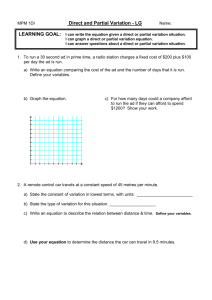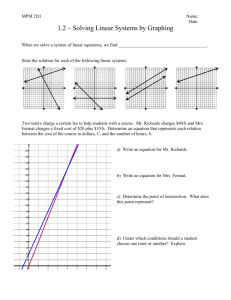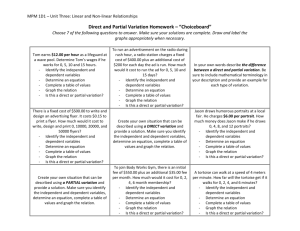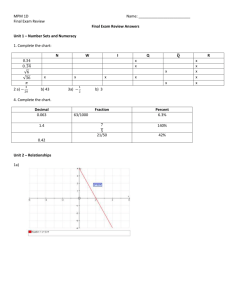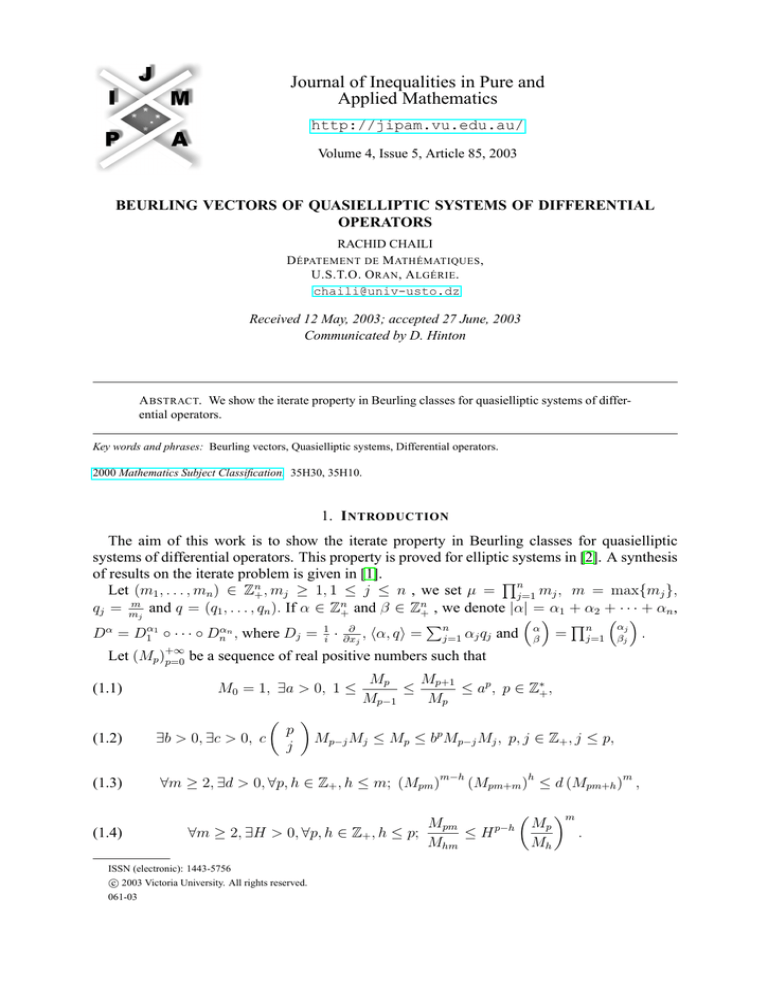
Journal of Inequalities in Pure and
Applied Mathematics
http://jipam.vu.edu.au/
Volume 4, Issue 5, Article 85, 2003
BEURLING VECTORS OF QUASIELLIPTIC SYSTEMS OF DIFFERENTIAL
OPERATORS
RACHID CHAILI
D ÉPATEMENT DE M ATHÉMATIQUES ,
U.S.T.O. O RAN , A LGÉRIE .
chaili@univ-usto.dz
Received 12 May, 2003; accepted 27 June, 2003
Communicated by D. Hinton
A BSTRACT. We show the iterate property in Beurling classes for quasielliptic systems of differential operators.
Key words and phrases: Beurling vectors, Quasielliptic systems, Differential operators.
2000 Mathematics Subject Classification. 35H30, 35H10.
1. I NTRODUCTION
The aim of this work is to show the iterate property in Beurling classes for quasielliptic
systems of differential operators. This property is proved for elliptic systems in [2]. A synthesis
of results on the iterate problem is given in [1].
Q
Let (m1 , . . . , mn ) ∈ Zn+ , mj ≥ 1, 1 ≤ j ≤ n , we set µ = nj=1 mj , m = max{mj },
qj = mmj and q = (q1 , . . . , qn ). If α ∈ Zn+ and β ∈ Zn+ , we denote |α| = α1 + α2 + · · · + αn ,
Q Pn
α
α1
1
∂
α
αn
D = D1 ◦ · · · ◦ Dn , where Dj = i · ∂xj , hα, qi = j=1 αj qj and αβ = nj=1 βjj .
Let (Mp )+∞
p=0 be a sequence of real positive numbers such that
(1.1)
M0 = 1, ∃a > 0, 1 ≤
p
j
Mp
Mp+1
≤
≤ ap , p ∈ Z∗+ ,
Mp−1
Mp
Mp−j Mj ≤ Mp ≤ bp Mp−j Mj , p, j ∈ Z+ , j ≤ p,
(1.2)
∃b > 0, ∃c > 0, c
(1.3)
∀m ≥ 2, ∃d > 0, ∀p, h ∈ Z+ , h ≤ m; (Mpm )m−h (Mpm+m )h ≤ d (Mpm+h )m ,
(1.4)
Mpm
∀m ≥ 2, ∃H > 0, ∀p, h ∈ Z+ , h ≤ p;
≤ H p−h
Mhm
ISSN (electronic): 1443-5756
c 2003 Victoria University. All rights reserved.
061-03
Mp
Mh
m
.
2
R ACHID C HAILI
∞
Let (Pj (x, D))N
coefj=1 be q−quasihomogeneous differential operators of order m with C
n
ficients in an open subset Ω of R , i.e.
X
Pj (x, D) =
ajα (x) Dα .
hα,qi≤m
We define the quasiprincipal symbol of the operator Pj (x, D) by
X
Pjm (x, ξ) =
ajα (x) ξ α .
hα,qi=m
Definition 1.1. The system (Pj )N
j=1 is said q−quasielliptic in Ω if for each x0 ∈ Ω we have
(1.5)
N
X
|Pjm (x0 , ξ)| =
6 0,
∀ξ ∈ Rn \{0}.
j=1
Definition 1.2. Let M = (Mp ) be a sequence satisfying
(1.1) – (1.4),
the space of Beurling vec-
N
∞
tors of the system (Pj (x, D))N
j=1 in Ω, denoted BM Ω, (Pj )j=1 , is the space of u ∈ C (Ω)
such that ∀K compact of Ω, ∀L > 0, ∃C > 0, ∀k ∈ Z+ ,
(1.6)
kPi1 . . . , Pik ukL2 (K) ≤ CLkm Mkm ,
where 1 ≤ il ≤ N, l ≤ k.
Definition 1.3. Let l = (l1 , . . . , ln ) ∈ Rn+ and M be a sequence satisfying (1.1) – (1.4), we
l
call anisotropic Beurling space in Ω, denoted BM
(Ω), the space of u ∈ C ∞ (Ω) such that
∀K compact of Ω, ∀L > 0, ∃C > 0, ∀α ∈ Z+n ,
n
Y
l
α
<α,l>
(1.7)
kD uk 2 ≤ CL
Mαj j .
L (K)
j=1
Remark 1.1. If lj = 1, j = 1, . . . , n, we obtain, thanks to (1.2) the definition of isotropic
Beurling space BM (Ω), (see [4]).
The principal result of this work is the following theorem:
Theorem 1.2. Let M and M 0 be two sequences satisfying (1.1) – (1.4) and
p
0
X
Mhm
Mpm+m
(1.8)
lim
= 0.
0
p→+∞
M
hm Mpm+m
h=0
q
Let (Pj )N
j=1 be q−quasielliptic system with BM (Ω) coefficients, then
N
q
BM 0 Ω, (Pj )j=1 ⊂ BM
0 (Ω) .
2. P RELIMINARY L EMMAS
Let ω be an open neighbourhood of the origin, we set K = k = hα, qi , α ∈ Zn+ and we
define
X
|u|k,ω =
kDα ukL2 (ω) , u ∈ C ∞ (ω) , k ∈ K.
hα,qi=k
If ρ > 0 we set
Bρ = x ∈ Rn ,
J. Inequal. Pure and Appl. Math., 4(5) Art. 85, 2003
n
X
j=1
(xj )
2
qj
! 12
<ρ
.
http://jipam.vu.edu.au/
B EURLING V ECTORS OF Q UASIELLIPTIC S YSTEMS OF D IFFERENTIAL O PERATORS
3
The two following lemmas are in [6].
Lemma 2.1. Let u ∈ C ∞ (Ω), r ∈ K and p ∈ Z+ , then
X
(2.1)
|u|pm+r,ω ≤
|Dα u|r,ω .
hα,qi=pm
Lemma 2.2. Let k = pm + r < pm + jm, where k, r ∈ K and p, j ∈ Z∗+ , then ∃c(j) > 0,
∀Bρ ⊂ ω, ∀ε ∈]0, 1[, ∀u ∈ C ∞ (ω) ,
r
|u|k,Bρ ≤ ε |u|(p+j)m,Bρ + c(j)ε− jm−r |u|pm,Bρ .
(2.2)
If a ∈ C ∞ (ω) , we denote [a, Dα ] u = Dα (au) − aDα u and if P is a differential operator,
we define [P, Dα ] u = Dα (P u) − P (Dα u) .
q
Lemma 2.3. Let B be a bounded subset of Rn and a ∈ BM
B , then ∀L > 0, ∃C > 0, ∀u ∈
C ∞ B , ∀p ∈ Z∗+ ,
1
X
X
Mpmµ µ
α
pm−k
(2.3)
|[a, D ] u|0,B ≤ C
L
|u|k,B .
Mkµ
k≤pm−1
hα,qi=pm
Proof. Let L > 0, as a ∈
k∈K
q
BM
B , there exists C1 > 0 such that
α
|D a| ≤ C1 L
hα,qi
n
Y
Mαj
qj
, ∀α ∈ Zn+ ,
j=1
therefore, with the Leibniz formula, we get
n
X α Y
qj
α
Dβ u C1 Lhα−β,qi
M
(2.4)
|[a, D ] u|0,B ≤
.
α
−β
j
j
0,B
β
j=1
β<α
We need the following easy inequality
qj µ ! µ1
µ1
n Y
hα, qi µ
α
αj
(2.5)
≤
≤
.
β
βj
hβ, qi µ
j=1
It is easy to check that from condition (1.2) we have
c
(2.6)
l−1
l
Y
M hj ≤
MPl
j=1
j=1
hence
n
Y
hj
≤b
(l−1)
Pl
j=1
hj
l
Y
Mhj ,
j=1
Mαj −βj
j=1
qj µ
Pnj=1 qj µ−1
1
M.
≤
c
This inequality with (1.2) and (2.5) imply
Y
Plj=1 qj 1
n
qj
Mhα,qiµ µ
1
α
Mαj −βj
≤
|u|k,B .
(2.7)
β
c
Mhβ,qiµ
j=1
pm−hβ,qi
As the number of α ∈ Z∗+ satisfying hα, qi = pm and α > β, is limited by C2
, where C2
depends only of n, then (2.4) and (2.7) give
Plj=1 qj
1
X
X
1
Mpmµ µ
pm−k
α
|[a, D ] u|0,B ≤
C1
(C2 L)
|u|k,B ,
c
M
kµ
k≤pm−1
hα,qi=pm
k∈K
J. Inequal. Pure and Appl. Math., 4(5) Art. 85, 2003
http://jipam.vu.edu.au/
4
R ACHID C HAILI
from which the desired estimate is obtained.
3. L OCAL E STIMATES
q
Let (Pj )N
j=1 be a q−quasielliptic system with coefficients in BM B , where B is a neighbourhood of the origin. The following lemma is a light modification of an analogous lemma in
[6, Lemma 2.3].
Lemma 3.1. Let ω be a small neighbourhood of the origin, ρ > 0 and δ ∈]0, 1[, such that
B ρ+δ ⊂ ω. Then there exists C > 0, not depending on ρ and δ, such that for any u ∈ C ∞ (ω) ,
N
X
X
|Pj u|0,Bρ+δ +
δ −m+k |u|k,Bρ+δ .
(3.1)
|u|m,Bρ ≤ C
j=1
k≤m−1
k∈K
Lemma 3.2. Let ω, ρ and δ be as in Lemma 3.1, then ∃C > 0, ∀L > 0, ∃A > 0, ∀p ∈ Z∗+ , ∀u ∈
C ∞ (ω)
(3.2)
|u|(p+1)m,Bρ ≤ C
N
X
|Pj u|pm,Bρ+δ + δ −m |u|pm,Bρ+δ +
j=1
1
|u|
(4e)m (p+1)m,Bρ+δ
p
X
Mpm+m
|u|hm,Bρ+δ
+A
L(p+1−h)m
M
hm
h=0
!
,
and
(3.3)
|u|m,Bρ ≤ C
N
X
1
|u|
+
(4e)m m,Bρ+δ
|Pj u|0,Bρ+δ + δ −m |u|0,Bρ+δ
j=1
!
.
Proof. From (2.1) and (3.1) we obtain
N
N
X
X
X
(3.4) |u|(p+1)m,Bρ ≤ C
|Pj u|pm,Bρ+δ +
|[Pj , Dα ] u|0,Bρ+δ
j=1
j=1 hα,qi=pm
+
X
δ −m+k |u|pm+k,Bρ+δ ,
k≤m−1
k∈K
Following the same idea as in the proof of Lemma 2.2 of [2], we get
1
X
X
M(pm+m)µ µ
α
0
pm+m−s
(3.5)
|[Pj , D ] u|0,Bρ+δ ≤ C
L
|u|s,Bρ+δ .
Msµ
s≤pm+m−1
hα,qi=pm
s∈K
On the other hand, there exists h ∈ Z+ and r ∈ K such that s = hm + r, r < nm − n, (see [6,
(1.3)]). As s ≤ pm + m − 1, then h ≤ p. From (2.2) we have
(3.6)
r
|u|s,Bρ+δ ≤ ε |u|(h+n)m,Bρ+δ + C2 ε− nm−r |u|hm,Bρ+δ
if s = hm + r, where 0 ≤ h ≤ p − n + 1 and 0 ≤ r < nm − n, and
(3.7)
r
|u|s,Bρ+δ ≤ ε |u|pm+m,Bρ+δ + C2 ε− jm−r |u|hm,Bρ+δ
if s = hm + r where h = p + 1 − j, 1 ≤ j ≤ n − 1 and 0 ≤ r ≤ jm − 1.
J. Inequal. Pure and Appl. Math., 4(5) Art. 85, 2003
http://jipam.vu.edu.au/
B EURLING V ECTORS OF Q UASIELLIPTIC S YSTEMS OF D IFFERENTIAL O PERATORS
5
Let ε0 ∈]0, 1[ and put
ε = ε0
µ1
Msµ
M(h+n)mµ
and
Msµ
L−nm+r in (3.6)
µ1
L−jm+r in (3.7) .
M(p+1)mµ
According to (1.3) we obtain for any s satisfying (3.6),
ε=ε
L−s
|u|s,Bρ+δ ≤ ε0
1
(Msµ ) µ
0
−hm
L−(h+n)m
0 0−m L
|u|
+
C
d
ε
2
1 |u|hm,Bρ+δ
1
(h+n)m,Bρ+δ
(Mhmµ ) µ
M(h+n)mµ µ
and for any s satisfying (3.7) ,
L−s
1
(Msµ ) µ
|u|s,Bρ+δ ≤ ε0
−hm
L−(p+1)m
00 0−nm L
|u|
+
C
d
ε
2
1 |u|hm,Bρ+δ .
1
(p+1)m,Bρ+δ
(Mhmµ ) µ
M(p+1)mµ µ
These inequalities and (3.5) give
X
|[Pj , Dα ] u|0,Bρ+δ ≤ C 0 nε0 |u|(p+1)m,Bρ+δ
hα,qi=pm
+c (ε0 )
p
X
L(p+1−h)m
h=0
0
0
m −1
Choosing ε = (2CC N n (4e) )
N
X
X
|[Pj , Dα ] u|0,Bρ+δ ≤
J=1 hα,qi=pm
M(pm+m)µ
Mhmµ
µ1
!
|u|hm,Bρ+δ
.
, then we obtain, with (1.4),
1
1
|u|
2C (4e)m (p+1)m,Bρ+δ
+A
p
X
(HL)(p+1−h)m
h=0
Mpm+m
|u|hm,Bρ+δ .
Mhm
It follows from this inequality: ∀L > 0, ∃A > 0,
(3.8)
N
X
X
|[Pj , Dα ] u|0,Bρ+δ ≤
J=1 hα,qi=pm
1
1
|u|
2C (4e)m (p+1)m,Bρ+δ
+A
p
X
h=0
L(p+1−h)m
Mpm+m
|u|hm,Bρ+δ .
Mhm
It remains the estimate of the third term of the right-hand side of (3.4) . From (2.2) , we have
k
|u|pm+k,Bρ+δ ≤ ε |u|pm+m,Bρ+δ + C2 ε− m−k |u|pm,Bρ+δ .
−1
Setting ε = ε0 δ m−k and choosing ε0 = (2C1 C (4e)m ) , then we obtain
X
1
1
0 −m
(3.9)
δ −m+k |u|pm+k,Bρ+δ ≤
|u|pm,Bρ+δ .
m |u|(p+1)m,Bρ+δ + C2 δ
2C
(4e)
k≤m−1
k∈K
The estimates (3.4) , (3.8) and (3.9) imply (3.2) . The estimate (3.3) is obtained from (3.1) and
(3.9) with p = 0.
J. Inequal. Pure and Appl. Math., 4(5) Art. 85, 2003
http://jipam.vu.edu.au/
6
R ACHID C HAILI
4. T HE M AIN R ESULT
Let R > 0, to every sequence M satisfying (1.1) – (1.4) we define
1
p
sup (R − ρ)pm |u|pm,Bρ .
σM
(u) =
Mpm R/2≤ρ<R
The following lemma is in [2].
0
Lemma 4.1. Let ω be as in Lemma3.1, R ∈]0,
1[ such that B R ⊂ ω, M, M two sequences
satisfying (1.1) – (1.4) and u ∈ BM 0 ω, (Pj )N
j=1 , then for any L > 0, there exists an increasing
positive sequence (Cp )+∞
p=0 such that ∀p, l ∈ Z+ ,
p
σM
0 (Pi0 · · · Pil u) ≤ Cp
(4.1)
0
Mpm+lm
Lpm+lm .
0
Mpm
where the sequence (Cp ) is constructed by recurrence,
Cp+1 = Cp
p
0
X
Mhm
Mpm+m
NC + A
0
Mhm Mpm+m
h=0
!
,
where C and A are the constants of Lemma 3.2 and C0 is the constant satisfying
0
kPi0 · · · Pil ukL2 (BR ) ≤ C0 Llm Mlm
.
Theorem 4.2. Let M and M 0 be two sequences satisfying (1.1) – (1.4) and
p
0
X
Mhm
Mpm+m
(4.2)
lim
= 0.
0
p→+∞
Mhm Mpm+m
h=0
q
Let (Pj )N
j=1 be q-quasielliptic system with coefficients in BM (Ω) , then
q
BM 0 Ω, (Pj )N
j=1 ⊂ BM 0 (Ω) .
Proof. We must verify (1.7) near every point x of Ω. By a translation of x at the origin, there
exists a neighbourhood ω of the origin for which the precedent lemmas are true. Let L > 0
and let (Cp )+∞
p=0 be as in Lemma 4.1, then from (4.2) there exists p0 ∈ Z+ such that Cp+1 ≤
2N CCp , p ≥ p0 , hence
Cp ≤ Cp0 (2N C)p−p0 ≤ Cp0 (2N C)pm+lm , ∀l ∈ Z+ .
For p ≤ p0 , this inequality is true because the sequence (Cp )+∞
p=0 is increasing.
Let R ∈]0.1[ such that B R ⊂ ω, from (4.1) we obtain
0
Mpm+lm
p
σM 0 (Pi0 · · · Pil u) ≤ Cp0
(2N CL)pm+lm , ∀p, l ∈ Z+ .
0
Mpm
In particular for l = 0,
pm
R
1
pm
p
|u|pm,BR/2 ≤ σM
,
0 (u) ≤ Cp0 (2N CL)
0
2
Mpm
hence
|u|pm,BR/2 ≤ Cp0
4N C
L
R
pm
0
Mpm
,
which can be rewritten as
(4.3)
0
∀L > 0, ∃C > 0, |u|pm,BR/2 ≤ CLpm Mpm
.
J. Inequal. Pure and Appl. Math., 4(5) Art. 85, 2003
http://jipam.vu.edu.au/
B EURLING V ECTORS OF Q UASIELLIPTIC S YSTEMS OF D IFFERENTIAL O PERATORS
7
The last inequality will allow us to conclude. In fact let k ∈ K, then there exists p ∈ Z+ and
r ∈ K, r < nm − n, such that k = pm + r. From (2.2) , (4.3) and (2.6) , we obtain
r
0
0
|u|k,BR/2 ≤ εC 0 L(p+n)m M(p+n)m
+ C 0 C 00 ε− nm−r Lpm Mpm
µ1
µ1
r
1
1
0
0
.
+ C 0 C 00 ε− nm−r Lpm Mpmµ
≤ εC 0 L(p+n)m M(p+n)mµ
c
c
Setting
ε=
0
M(pm+r)µ
! µ1
0
M(p+n)mµ
L−nm+r ,
then from (1.3) we get
0
|u|k,BR/2 ≤ C1 Lk Mkµ
(4.4)
µ1
.
By an imbedding theorem of anisotropic Sobolev spaces (see [5]), from (4.4) and (1.2) we
obtain
µ1
0
sup |Dα u (x)| ≤ C2 (bL)hα,qi Mhα,qiµ
.
BR/2
The last estimate, with (2.6) gives
hα,qi
sup |Dα u (x)| ≤ C3 (bL)
bhα,qinµ
BR/2
n
Y
! µ1
Mα0 j qj µ
j=1
≤ C3 (bL)hα,qi
bhα,qinµ
≤ C3 b(1+n+mµ) L
hα,qi
n
Y
bqj µ(αj qj µ) Mα0 j
j=1
n Y
Mα0 j
qj
qj µ
! µ1
,
j=1
q
from there u ∈ BM
0 BR/2 .
As a corollary we obtain from Theorem 1.2, the principal result of [2]. Theorem 1.2 also
gives a result of regularity of solutions of differential equations in Beurling classes.
Corollary 4.3. Under the assumptions of Theorem 1.2, the following assertions are equivalent:
q
i) u ∈ D0 (Ω) and Pj u ∈ BM
0 (Ω) ,
q
ii) u ∈ BM 0 (Ω) .
q
For anisotropic projective Gevrey classes G{s},q (Ω) = BM
(Ω), Mp = (p!)s , s ≥ 1, we have
the same result.
Corollary 4.4. Let s, s0 be such that s0 > s ≥ 1 and (Pj )N
j=1 q−quasielliptic system with
coefficients in G{s},q (Ω) , then
N
{s}
G
Ω, (Pj )j=1 ⊂ G{s},q (Ω) .
Corollary 4.5. Let M and M 0 be two sequences satisfying (1.1) – (1.4) and
(4.5)
p
0
X
Mhm
Mpm+m
lim
= 0,
0
p→+∞
Mhm Mpm+m
h=0
J. Inequal. Pure and Appl. Math., 4(5) Art. 85, 2003
http://jipam.vu.edu.au/
8
R ACHID C HAILI
and let (Pj )N
j=1 be an elliptic system with coefficients in BM (Ω) , then
N
BM 0 Ω, (Pj )j=1 ⊂ BM 0 (Ω) .
R EFERENCES
[1] P. BOLLEY, J. CAMUS AND L. RODINO, Hypoellipticité analytique-Gevrey et itérés d’opérateurs,
Ren. Sem. Mat. Univers. Politec. Torino, 45(3) (1989), 1–61.
[2] C. BOUZAR AND R. CHAILI, Régularité des vecteurs de Beurling de systèmes elliptiques, Maghreb
Math. Rev., 9(1-2) (2000), 43–53.
[3] C. BOUZAR AND R. CHAILI, Vecteurs Gevrey d’opérateurs différentiels qusihomogènes, Bull.
Belg. Math. Soc., 9 (2002), 299–310.
[4] J.L. LIONS AND E. MAGENES, Problèmes aux Limites Non Homogènes et Applications, t. 3,
Dunod Paris, 1970.
(r ,...,rn )
[5] P.I. LIZORKIN, Nonisotropic Bessel potentials. Imbedding theorems for Sobolev spaces Lp 1
with fractional derivatives, Soviet Math. Dokl., 7(5) (1966), 1222–1226.
[6] L. ZANGHIRATI, Iterati di operatori quasi-ellittici e classi di Gevrey, Boll. U.M.I., 5(18-B) (1981),
411–428.
J. Inequal. Pure and Appl. Math., 4(5) Art. 85, 2003
http://jipam.vu.edu.au/

